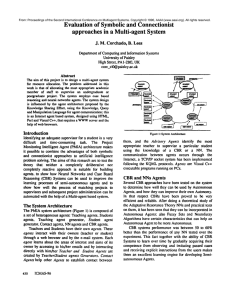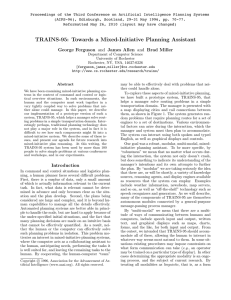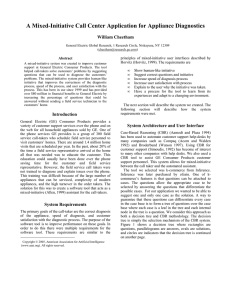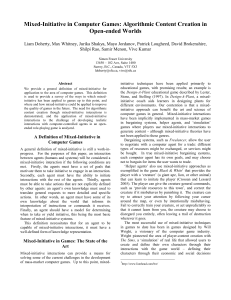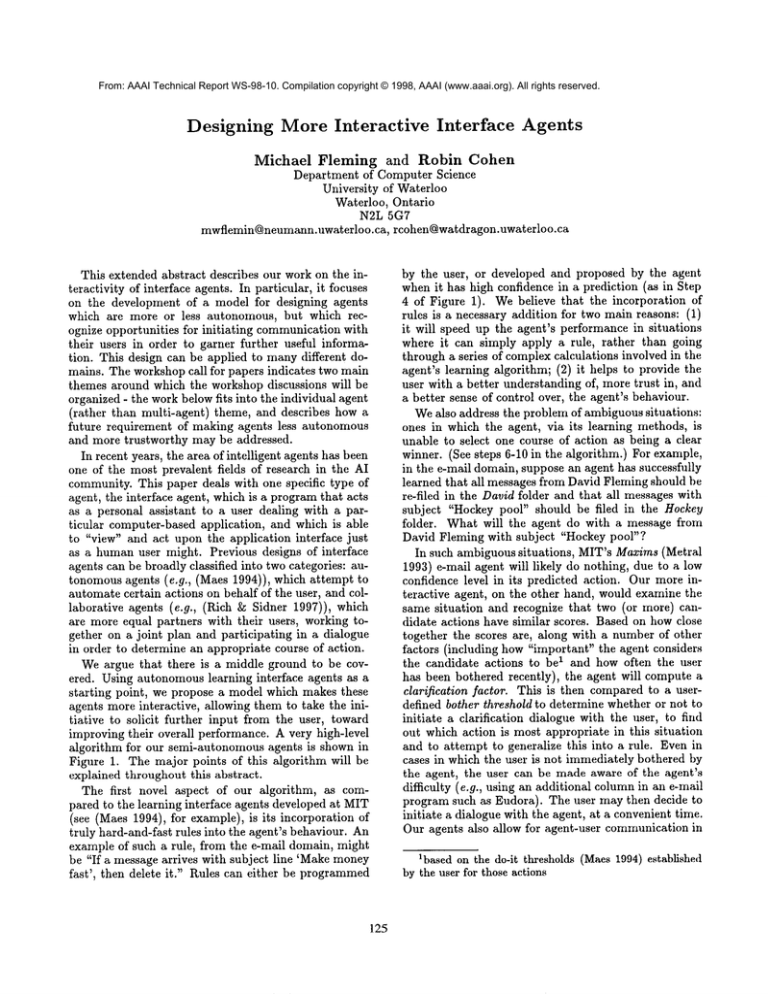
From: AAAI Technical Report WS-98-10. Compilation copyright © 1998, AAAI (www.aaai.org). All rights reserved.
Designing
More Interactive
Interface
Agents
Michael
Fleming
and Robin Cohen
Department of Computer Science
University of Waterloo
Waterloo, Ontario
N2L 5G7
mwflemin@neumann.uwaterloo.ca, rcohen@watdragon.uwaterloo.ca
This extended abstract describes our work on the interactivity of interface agents. In particular, it focuses
on the development of a model for designing agents
which are more or less autonomous, but which recognize opportunities for initiating communicationwith
their users in order to garner further useful information. This design can be applied to manydifferent domains. The workshop call for papers indicates two main
themes around which the workshop discussions will be
organized - the work below fits into the individual agent
(rather than multi-agent) theme, and describes how
future requirement of making agents less autonomous
and more trustworthy may be addressed.
In recent years, the area of intelligent agents has been
one of the most prevalent fields of research in the AI
community. This paper deals with one specific type of
agent, the interface agent, which is a programthat acts
as a personal assistant to a user dealing with a particular computer-based application, and which is able
to "view" and act upon the application interface just
as a humanuser might. Previous designs of interface
agents can be broadly classified into two categories: autonomous agents (e.g., (Maes 1994)), which attempt
automate certain actions on behalf of the user, and collaborative agents (e.g., (Rich & Sidner 1997)), which
are more equal partners with their users, working together on a joint plan and participating in a dialogue
in order to determine an appropriate course of action.
Weargue that there is a middle ground to be covered. Using autonomous learning interface agents as a
starting point, we propose a model which makes these
agents more interactive, allowing them to take the initiative to solicit further input from the user, toward
improving their overall performance. A very high-level
algorithm for our semi-autonomous agents is shown in
Figure 1. The major points of this algorithm will be
explained throughout this abstract.
The first novel aspect of our algorithm, as compared to the learning interface agents developed at MIT
(see (Maes 1994), for example), is its incorporation
truly hard-and-fast rules into the agent’s behaviour. An
example of such a rule, fl’om the e-mail domain, might
be "If a message arrives with subject line ~Makemoney
fast’, then delete it." Rules can either be programmed
125
by the user, or developed and proposed by the agent
when it has high confidence in a prediction (as in Step
4 of Figure 1). Webelieve that the incorporation of
rules is a necessary addition for two main reasons: (1)
it will speed up the agent’s performance in situations
where it can simply apply a rule, rather than going
through a series of complexcalculations involved in the
agent’s learning algorithm; (2) it helps to provide the
user with a better understanding of, more trust in, and
a better sense of control over, the agent’s behaviour.
Wealso address the problem of ambiguoussituations:
ones in which the agent, via its learning methods, is
unable to select one course of action as being a clear
winner. (See steps 6-10 in the algorithm.) For example,
in the e-mail domain, suppose an agent has successfully
learned that all messages from David Fleming should be
re-filed in the David folder and that all messages with
subject "Hockey pool" should be filed in the Hockey
folder. What will the agent do with a message from
David Fleming with subject "Hockey pool"?
In such ambiguous situations, MIT’s Maxims (Metral
1993) e-mail agent will likely do nothing, due to a low
confidence level in its predicted action. Our more interactive agent, on the other hand, would examine the
same situation and recognize that two (or more) candidate actions have similar scores. Based on how close
together the scores are, along with a number of other
factors (including how"important" the agent considers
the candidate actions to be1 and how often the user
has been bothered recently), the agent will compute
clarification factor. This is then compared to a userdefined bother threshold to determine whether or not to
initiate a clarification dialogue with the user, to find
out which action is most appropriate in this situation
and to attempt to generalize this into a rule. Even in
cases in which the user is not immediately bothered by
the agent, the user can be made aware of the agent’s
difficulty (e.g., using an additional columnin an e-mail
program such as Eudora). The user may then decide to
initiate a dialogue with the agent, at a convenient time.
Our agents also allow for agent-user communication in
1based on the do-it thresholds (Maes1994)established
by the user for those actions
the event of conflicts occurring in the actual rules programmedby the user (Step 0). This communication
not through natural language, but rather via dialogue
boxes, menusand buttons in a graphical user interface.
The goal of interface agents is to help the user deal
with a particular computer-based application, and to
off-load some of the tedious or repetitive work. Our
work looks at the degree to which such systems communicate with a humanuser. There is a definite tradeoff involved here: both the agent and user can benefit a great deal from increased interaction; however,
an agent which constantly interrupts with questions
and explanations is bound to become an annoyance.
The model which we propose aims to provide improved
performance over strictly learning interface agents, allowing users to be more aware (and trusting) of their
agents’ activities, while keeping the bother level to a
minimum.
Moreover, our work has something to offer to
the growing mixed-initiative
research area ((Allen
1994), (Burstein & McDermott 1996)). In providing
opportunities for both agents and users to take the initiative, we have presented one approach for designing
mixed-initiative interface agents.
Although this discussion has focused on e-mail
agents, the model is applicable to a broad range of application domains.
INPUT:A signal that there exists a new situation to
be addressed (e.g., in the e-mail domain:a new mail
messagearrives, the user has just finished reading a
message,etc.)
OUTPUT:
The agent has either completed an action
on behalf of the user, or has suggested an action to the
user, for the current situation.
(o) Consult rule
database for applicable rules previously created by the user (with or without the
agent’s help). If a single rule is found to apply,
then use that rule. If twoor moreconflicting rides
are found, initiate rule conflict dialoguewith user.
If no rules are found to apply, then proceed with
step 1.
(1) Use learning techniques to get possible actions
A1,..., An
(2) if choice of action A is clear" then
(3) Computeconfidence value C (as in the
agents - see (Kozierok 1993), for example)
Acknowledgements
This work was supported in part by the Natural Sciences and Engineering Research Council.
(4) if C > do-it threshold then perform action
A and indicate that there is a proposednile for
the user to approve/reject/edit
References
(5) else if C > tell-me threshold then suggest
action A
Allen, J. 1994. Mixed-initiative planning: Position paper. Presented at the ARPA/I~omeLabs Planning Initiative Workshop. Available on the World Wide Web
at http://www.cs.rochester.edu/research/trains/mip.
Burstein, M., and McDermott, D. 1996. Issues in
the development of human-computer mixed-initiative
planning. In Gorayska, B., and Mey, J., eds., In Search
of a HumaneInterface. Elsevier Science B.V. 285-303.
Kozierok, R. 1993. A learning approach to knowledge
acquisition for intelligent interface agents. Master of
science thesis, Massachusetts Institute of Technology,
Cambridge MA.
Maes, P. 1994. Agents that reduce work and information overload. Communications of the ACM37(7):3140.
Metral, M. 1993. Design of a generic learning interface agent. Bachelor of science thesis, Massachusetts
Institute of Technology, Cambridge MA.
Rich, C., and Sidner, C. 1997. Collagen: Whenagents
collaborate with people. In First International Conference on Autonomous Agents, 284-291.
126
(6) else//choice unclear because two or more actions
have similar scores
(7) if peer agents exist and are able to provide
trustworthy advice then automate/suggest recommendedaction
(8) else //choice still :mclear
(9) Computeclarification factor CF.
(10) if CF> user-defined bother threshold
then initiate dialogue with user.
aThe choice is considered clear if the score computed for the
highest-scoring action exceeds the score of the next best choice by a
constant difference threshold (say, 10%).
Figure 1: High-level algorithm for our more interactive
interface agents

